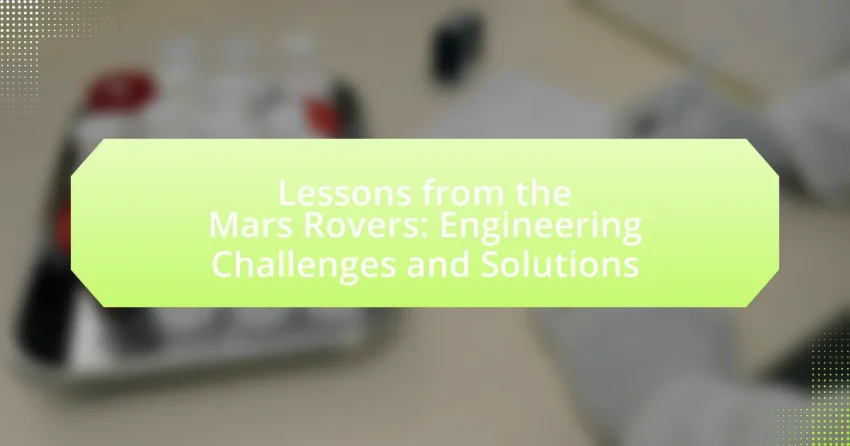The article focuses on the engineering challenges and solutions derived from the Mars Rover missions, highlighting key lessons learned from the experiences of rovers like Curiosity and Perseverance. It discusses the importance of robust engineering design, adaptability in mission planning, and long-term data collection, emphasizing how these factors contributed to mission success. Specific engineering challenges, such as extreme temperatures, dust accumulation, and communication delays, are examined alongside the innovative solutions implemented to address them. The article also explores the evolution of technologies in navigation, communication, and scientific instrumentation, as well as the collaborative efforts that facilitated overcoming obstacles during the missions. Overall, it provides insights that can inform future space exploration endeavors.

What are the key lessons learned from the Mars Rovers?
The key lessons learned from the Mars Rovers include the importance of robust engineering design, adaptability in mission planning, and the value of long-term data collection. The engineering design of the rovers, such as the Curiosity and Perseverance, demonstrated that systems must withstand extreme environmental conditions, including radiation and temperature fluctuations, which are critical for mission success. Adaptability was highlighted during the missions when unexpected challenges arose, requiring teams to modify operational strategies in real-time, such as altering navigation paths or adjusting scientific objectives. Additionally, the long-term data collection from these rovers has provided invaluable insights into Mars’ geology and climate, reinforcing the necessity of sustained exploration to understand planetary evolution. These lessons are supported by the successful completion of numerous scientific objectives and the extensive data returned from the missions, which have significantly advanced our knowledge of Mars.
How have engineering challenges shaped the design of Mars Rovers?
Engineering challenges have significantly influenced the design of Mars Rovers by necessitating innovative solutions to operate in the harsh Martian environment. For instance, the extreme temperatures, dust storms, and radiation levels on Mars required the development of robust materials and advanced thermal control systems to ensure the rovers’ functionality and longevity. The Spirit and Opportunity rovers, launched in 2003, were designed with solar panels that could withstand dust accumulation, leading to the incorporation of a cleaning mechanism that utilized the rovers’ mobility to brush off dust. Additionally, the Curiosity rover, which landed in 2012, faced the challenge of landing safely on Mars, resulting in the implementation of the “sky crane” landing system, a novel approach that allowed for a controlled descent and precise placement on the surface. These engineering adaptations demonstrate how specific challenges have directly shaped the technological advancements and design features of Mars Rovers, ensuring their successful exploration missions.
What specific engineering challenges did the Mars Rovers face?
The Mars Rovers faced several specific engineering challenges, including extreme temperatures, dust accumulation, communication delays, and mobility on uneven terrain. Extreme temperatures on Mars can range from minus 125 degrees Celsius at night to plus 20 degrees Celsius during the day, requiring robust thermal protection systems to ensure the rovers’ electronics and instruments function properly. Dust accumulation on solar panels and sensors can significantly reduce energy efficiency and data accuracy, necessitating designs that minimize dust impact. Communication delays, due to the distance between Earth and Mars, can reach up to 20 minutes one way, complicating real-time control and requiring autonomous navigation capabilities. Additionally, the rovers had to navigate uneven and rocky terrain, which posed risks for mobility and stability, leading to the development of advanced suspension systems and obstacle avoidance algorithms. These challenges were addressed through innovative engineering solutions, ensuring the rovers could successfully conduct their missions on the Martian surface.
How were these challenges addressed in Rover design?
The challenges in Rover design were addressed through innovative engineering solutions and advanced technology integration. For instance, the need for mobility on diverse terrains led to the development of robust wheel designs and suspension systems that can adapt to rocky and sandy surfaces. Additionally, power supply challenges were mitigated by utilizing solar panels and radioisotope thermoelectric generators, ensuring continuous operation in harsh environments. Furthermore, communication issues were resolved by implementing high-gain antennas and relay satellites, enhancing data transmission back to Earth. These strategies collectively demonstrate how engineering ingenuity effectively tackled the unique challenges faced by Mars Rovers.
What innovations emerged from the Mars Rover missions?
The Mars Rover missions have led to significant innovations in robotics, autonomous navigation, and scientific instrumentation. Notably, the development of advanced autonomous navigation systems allows rovers to traverse complex terrains without direct human control, exemplified by the Curiosity rover’s ability to navigate Martian landscapes using onboard sensors and algorithms. Additionally, the use of miniaturized scientific instruments, such as the ChemCam on Curiosity, enables detailed analysis of Martian rocks and soil from a distance, enhancing our understanding of the planet’s geology. These innovations have not only advanced space exploration but also influenced technologies in various fields, including robotics and remote sensing on Earth.
How did technology evolve through the Mars Rover projects?
Technology evolved significantly through the Mars Rover projects by advancing in areas such as autonomous navigation, scientific instrumentation, and communication systems. The first Mars Rover, Sojourner, launched in 1996, introduced basic autonomous navigation capabilities, allowing it to traverse the Martian surface with minimal human intervention. Subsequent missions, like Spirit and Opportunity, enhanced these capabilities with improved sensors and algorithms, enabling more complex terrain navigation and obstacle avoidance.
The Curiosity Rover, launched in 2011, marked a leap in scientific instrumentation, featuring a suite of advanced tools for analyzing soil and rock samples, including the ChemCam and SAM (Sample Analysis at Mars) instruments. This evolution allowed for more detailed and varied scientific investigations compared to earlier rovers.
The Perseverance Rover, which landed in 2021, further advanced communication technology by utilizing a high-data-rate communication system that allows for faster transmission of data back to Earth. This evolution in technology reflects a continuous improvement in the ability to explore and analyze Mars, demonstrating how each mission built upon the successes and lessons learned from its predecessors.
What role did collaboration play in overcoming engineering obstacles?
Collaboration was essential in overcoming engineering obstacles during the Mars Rover missions. Teams of engineers, scientists, and technicians worked together across various disciplines to address complex challenges, such as the harsh Martian environment and the need for precise navigation. For instance, the successful landing of the Curiosity Rover in 2012 was a result of coordinated efforts among over 1,000 team members from NASA’s Jet Propulsion Laboratory, who integrated expertise in robotics, software, and atmospheric science. This collaborative approach enabled innovative solutions, such as the development of the Sky Crane landing system, which was crucial for safely delivering the rover to the Martian surface.

What are the most significant engineering challenges encountered?
The most significant engineering challenges encountered in the Mars Rovers include extreme environmental conditions, communication delays, and power management. Extreme temperatures on Mars can range from minus 195 degrees Fahrenheit at the poles to 70 degrees Fahrenheit at the equator, which necessitates robust thermal protection systems. Communication delays, averaging 13 to 24 minutes one way, complicate real-time operations and require autonomous navigation capabilities. Additionally, power management is critical, as rovers rely on solar panels or radioisotope thermoelectric generators, necessitating efficient energy use to sustain operations during dust storms or low sunlight periods. These challenges have been documented in NASA’s mission reports and engineering analyses, highlighting the complexities of designing and operating rovers in such a hostile environment.
How did environmental conditions on Mars impact Rover engineering?
Environmental conditions on Mars significantly influenced Rover engineering by necessitating robust designs to withstand extreme temperatures, dust storms, and radiation. Engineers had to create Rovers with thermal insulation to operate in temperatures that can drop to minus 125 degrees Celsius at night and can reach up to 20 degrees Celsius during the day. Additionally, the presence of fine dust required the development of dust-resistant components and seals to prevent mechanical failures. The Rovers also needed radiation shielding to protect sensitive electronics from cosmic rays, which are more intense on Mars due to its thin atmosphere. These engineering adaptations were crucial for ensuring the longevity and functionality of the Rovers in the harsh Martian environment.
What specific environmental factors were considered in Rover design?
The specific environmental factors considered in Rover design include extreme temperature variations, dust accumulation, radiation exposure, and terrain challenges. These factors are critical as they directly impact the Rover’s functionality and longevity on Mars. For instance, temperature fluctuations can range from minus 125 degrees Celsius at night to plus 20 degrees Celsius during the day, necessitating thermal insulation and heating systems. Dust accumulation poses risks to solar panels and mechanical components, leading to the design of dust-resistant materials and cleaning mechanisms. Additionally, the high levels of radiation on Mars require protective shielding to safeguard sensitive electronics. Finally, the rugged terrain demands robust mobility systems capable of navigating rocks and slopes, influencing wheel design and suspension systems.
How did engineers simulate Martian conditions during testing?
Engineers simulated Martian conditions during testing by creating controlled environments that replicate the planet’s atmosphere, temperature, and surface conditions. They utilized vacuum chambers to mimic the low atmospheric pressure of Mars, which is about 0.6% of Earth’s, and temperature-controlled environments to achieve the extreme cold, ranging from -125 to 20 degrees Celsius. Additionally, engineers employed regolith simulants to replicate the Martian soil, allowing for realistic testing of rover mobility and equipment functionality. These methods ensure that the rovers can withstand and operate effectively in the harsh conditions expected on Mars.
What mechanical failures occurred during the missions?
During the Mars rover missions, several mechanical failures occurred, including issues with the rovers’ mobility systems, power systems, and scientific instruments. For instance, the Spirit rover experienced a failure in its right front wheel, which became stuck in soft soil, limiting its mobility and ability to conduct scientific operations. Additionally, the Opportunity rover faced a failure in its solar panels due to dust accumulation, which reduced its power generation capabilities. These mechanical failures highlight the challenges faced in the harsh Martian environment, where dust, temperature fluctuations, and rocky terrain can significantly impact rover functionality and mission success.
What were the causes of these mechanical failures?
The causes of the mechanical failures in the Mars Rovers primarily included design flaws, environmental challenges, and component wear. Design flaws, such as inadequate testing of materials under Martian conditions, led to unexpected failures. Environmental challenges, including extreme temperatures and dust accumulation, adversely affected the rovers’ functionality. Additionally, component wear over time, particularly in moving parts like wheels and joints, contributed to mechanical breakdowns. These factors collectively highlight the complexities of engineering for extraterrestrial environments, as evidenced by the operational difficulties faced by both Spirit and Opportunity rovers during their missions.
How were these failures resolved or mitigated in subsequent missions?
Failures in previous Mars rover missions were resolved or mitigated in subsequent missions through enhanced engineering designs, rigorous testing protocols, and improved software algorithms. For instance, the issue of communication delays experienced during the Mars Exploration Rovers was addressed by implementing more robust data transmission systems and refining the command sequences to ensure better synchronization. Additionally, the Curiosity rover incorporated advanced navigation systems that utilized improved sensors and algorithms to avoid obstacles, which were lessons learned from the Spirit and Opportunity missions. These adaptations were validated by the successful deployment and operation of the Perseverance rover, which demonstrated enhanced reliability and performance in challenging Martian conditions.

What solutions were implemented to overcome these challenges?
The solutions implemented to overcome engineering challenges faced by the Mars Rovers included advanced robotics, enhanced communication systems, and innovative power management techniques. For instance, the use of autonomous navigation algorithms allowed the rovers to traverse the Martian terrain without direct human intervention, significantly reducing the risk of getting stuck or damaged. Additionally, the implementation of high-gain antennas improved data transmission rates back to Earth, ensuring that scientists received critical information in a timely manner. Furthermore, the development of radioisotope thermoelectric generators provided a reliable power source, enabling the rovers to operate in the harsh Martian environment for extended periods. These solutions were essential for the successful operation and longevity of the Mars Rovers.
How did engineers ensure Rover mobility on the Martian surface?
Engineers ensured Rover mobility on the Martian surface by designing advanced mobility systems that include robust wheels, suspension systems, and autonomous navigation capabilities. The Rovers, such as Curiosity and Perseverance, feature specially designed wheels made from aluminum with a unique tread pattern to provide traction on rocky and sandy terrain. Additionally, the suspension system allows for flexibility and stability over uneven surfaces, enabling the Rover to traverse obstacles up to 25 centimeters high. Autonomous navigation software, utilizing data from onboard cameras and sensors, enables the Rovers to make real-time decisions about their path, enhancing their ability to navigate the challenging Martian landscape. These engineering solutions have been validated through extensive testing on Earth and simulations that replicate Martian conditions, ensuring the Rovers can effectively explore and conduct scientific research on Mars.
What technologies were developed for navigation and terrain adaptation?
Technologies developed for navigation and terrain adaptation include autonomous navigation systems, advanced imaging sensors, and terrain mapping algorithms. Autonomous navigation systems, such as those used in the Mars rovers, enable robots to traverse complex landscapes without human intervention by utilizing onboard processing to analyze terrain features in real-time. Advanced imaging sensors, including stereo cameras and LIDAR, provide detailed 3D maps of the environment, allowing for precise obstacle detection and avoidance. Terrain mapping algorithms, like the ones implemented in the Mars Exploration Rovers, utilize data from these sensors to create accurate representations of the terrain, facilitating safe navigation across varied surfaces. These technologies have been validated through successful missions, demonstrating their effectiveness in challenging extraterrestrial environments.
How did the design of wheels and suspension systems evolve?
The design of wheels and suspension systems evolved significantly from simple wooden wheels to advanced systems used in modern vehicles and space exploration. Early wheels, dating back to around 3500 BC, were solid disks made from wood, which limited mobility and comfort. The introduction of spokes in the 6th century BC reduced weight and improved strength, allowing for faster and more efficient travel.
In the 19th century, the development of rubber tires enhanced grip and shock absorption, leading to a smoother ride. The evolution continued with the advent of suspension systems, which began with leaf springs and progressed to more complex systems like coil springs and air suspension, improving vehicle handling and comfort.
In the context of Mars rovers, the design of wheels and suspension systems has adapted to extreme conditions. For instance, the Curiosity rover features a rocker-bogie suspension system that allows it to traverse rocky terrain while maintaining stability. This design evolution is crucial for navigating the Martian landscape, demonstrating how advancements in wheel and suspension technology have been applied to meet specific engineering challenges in space exploration.
What communication challenges did the Mars Rovers face?
The Mars Rovers faced significant communication challenges primarily due to the vast distance between Earth and Mars, which can reach up to 250 million kilometers. This distance results in a communication delay of approximately 13 to 24 minutes one way, making real-time communication impossible. Additionally, the Rovers had to operate in a harsh environment with potential interference from Martian terrain and atmospheric conditions, which could disrupt signals. The limited bandwidth available for data transmission further complicated the situation, restricting the amount of information that could be sent back to Earth. These factors collectively hindered the Rovers’ ability to communicate effectively and necessitated the development of autonomous systems to manage operations without immediate human input.
How were communication systems designed to function on Mars?
Communication systems on Mars were designed to function through a combination of relay satellites and direct-to-Earth transmissions. NASA’s Mars Reconnaissance Orbiter and Mars Odyssey serve as relay stations, enabling data transfer between rovers and Earth. These systems utilize radio frequencies to transmit signals, overcoming the challenges posed by Mars’ atmosphere and distance from Earth, which can cause delays of up to 22 minutes for signals traveling one way. The design incorporates redundancy and error-correction protocols to ensure reliable communication despite potential disruptions.
What strategies were used to maintain communication with Earth?
The primary strategy used to maintain communication with Earth involved the use of high-gain antennas and relay satellites. High-gain antennas on the Mars rovers enabled direct communication with Earth, allowing for the transmission of scientific data and receiving commands. Additionally, the Mars Reconnaissance Orbiter and other relay satellites facilitated continuous communication by relaying signals between the rovers and mission control, ensuring that data could be sent and received even when the rovers were out of direct line of sight with Earth. This dual approach of direct communication and relay systems proved essential for the success of the missions, as it allowed for timely updates and operational control.
What lessons can be applied to future space exploration missions?
Future space exploration missions can benefit from the lessons learned during the Mars rover missions, particularly in areas such as robust engineering design, autonomous navigation, and effective communication systems. The Mars rovers, such as Curiosity and Perseverance, demonstrated the importance of designing equipment that can withstand harsh environmental conditions, as evidenced by their successful operation in extreme temperatures and dust storms. Additionally, the use of autonomous navigation systems allowed the rovers to traverse complex terrains without real-time human intervention, highlighting the need for advanced AI and machine learning capabilities in future missions. Furthermore, the communication challenges faced during the Mars missions underscored the necessity for reliable data transmission methods, which can be applied to ensure consistent contact with spacecraft in distant locations. These insights are crucial for enhancing the success and safety of upcoming space exploration endeavors.
How can the experiences from Mars Rovers inform the design of future missions?
The experiences from Mars Rovers can inform the design of future missions by providing critical insights into engineering challenges and operational strategies. For instance, the Mars Curiosity Rover’s experience with extreme temperatures and dust storms has led to the development of more robust thermal protection systems and dust-resistant components for future rovers. Additionally, the challenges faced by the Perseverance Rover in navigating rocky terrain have emphasized the need for advanced mobility systems and autonomous navigation technologies. These lessons are supported by data from the missions, such as Curiosity’s successful adaptation to Martian conditions, which has been documented in NASA reports, showcasing the importance of iterative design based on real-world performance.
What best practices emerged from the engineering processes of Mars Rovers?
Best practices that emerged from the engineering processes of Mars Rovers include rigorous testing protocols, modular design, and effective communication among interdisciplinary teams. Rigorous testing protocols, such as the use of simulations and environmental testing, ensure that rovers can withstand harsh Martian conditions, as demonstrated by the extensive testing of the Curiosity rover before its launch. Modular design allows for easier upgrades and repairs, which was crucial for the Spirit and Opportunity rovers, enabling them to adapt to unforeseen challenges during their missions. Effective communication among engineers, scientists, and mission planners fosters collaboration and innovation, as seen in the successful deployment of the Perseverance rover, which involved input from diverse expertise to optimize its design and functionality.
What practical tips can be learned from the Mars Rover engineering experience?
Practical tips learned from the Mars Rover engineering experience include the importance of rigorous testing, modular design, and redundancy in systems. Rigorous testing ensures that all components can withstand extreme conditions, as demonstrated by the extensive simulations and tests conducted before launch, which helped identify potential failures. Modular design allows for easier upgrades and repairs, as seen in the interchangeable parts of the rovers, facilitating maintenance and adaptability. Redundancy in critical systems, such as multiple communication pathways, enhances reliability, proven by the successful operation of the Mars rovers despite various challenges encountered during their missions.
